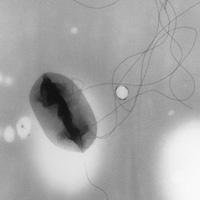
|
 |
E.coli’s Defense Mechanism Uncovered
Sep 29, 2005 - 9:28:00 PM, Reviewed by: Dr.
|
|
“Nitric oxide is produced by the body to fight infections. We discovered a mechanism that allows bacterial cells to detect nitric oxide and turn it into something that’s harmless to the cell”
|
By Georgia Institute of Technology,
Researchers at the Georgia Institute of Technology and the John Innes Centre in the United Kingdom have uncovered a mechanism with which disease-causing bacteria may thwart the body’s natural defense responses. The findings, which could ultimately lead to the development of more effective antibiotics, appear in the September 29, 2005 issue of the journal Nature.
“Nitric oxide is produced by the body to fight infections. We discovered a mechanism that allows bacterial cells to detect nitric oxide and turn it into something that’s harmless to the cell,” said Stephen Spiro, associate professor in the School of Biology at Georgia Tech.
Spiro, along with colleagues Benoît D'Autréauz, Nicholas Tucker and Ray Dixon from the John Innes Centre, studied a non-pathogenic strain of Escherichia coli, which is very closely related to salmonella bacteria.
The pathogenic forms of E. coli and salmonella are usually transmitted to humans through undercooked meat, unwashed vegetables and cross contamination from surfaces on which these foods were prepared. Infections from either of these organisms can cause diarrhea, abdominal cramps and sometimes more serious illnesses that require hospitalization. E.coli doesn’t respond well to antibiotics, while salmonella has developed several drug-resistant strains. Learning how the bacteria handle the body’s immune response is the first step in developing more effective medicines.
Spiro and colleagues focused their study on the NorR protein and the role it plays in reducing the levels of nitric oxide. In response to nitric oxide, NorR binds to DNA in order to regulate expression of an enzyme that reduces the amount of nitric oxide in the bacteria. Since nitric oxide binds to metals, the researchers suspected that there might be a metal in the protein.
 |
| Escherichia coli O157:H7 strain |
“It turns out that the protein NorR contains a single molecule of iron,” said Spiro. “Our study found that the nitric oxide binds to the iron, which in turn activates the protein.”
Once activated, the protein controls expression of the norVW genes. These genes encode an enzyme that removes the nitric oxide, allowing the bacteria to fend off the body’s defenses.
The discovery of this mechanism is just the first step in what Spiro hopes will be a line of research aimed at disrupting the mechanism by which the bacteria rids itself of the poisonous nitric oxide.
“If we can interfere with the mechanism, it could lead to better antibiotics and better treatments,” said Spiro.
The research was funded by a grant from the Biotechnology and Biological Sciences Research Council. 
- September 29, 2005 issue of the journal Nature.
www.gatech.edu
The Georgia Institute of Technology is one of the nation's premiere research universities. Ranked among U.S. News & World Report's top 10 public universities, Georgia Tech educates more than 16,000 students every year through its Colleges of Architecture, Computing, Engineering, Liberal Arts, Management and Sciences. Tech maintains a diverse campus and is among the nation's top producers of women and African-American engineers. The Institute offers research opportunities to both undergraduate and graduate students and is home to more than 100 interdisciplinary units plus the Georgia Tech Research Institute. During the 2003-2004 academic year, Georgia Tech reached $341.9 million in new research award funding.
The research was funded by a grant from the Biotechnology and Biological Sciences Research Council.
|
For any corrections of factual information, to contact the editors or to send
any medical news or health news press releases, use
feedback form
Top of Page
|
|
|
|